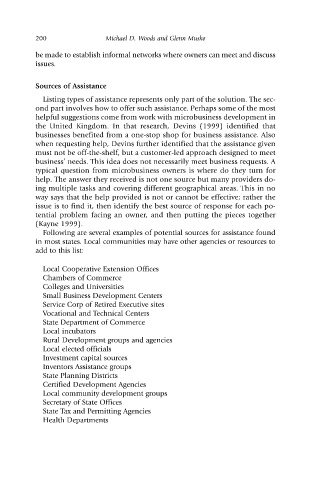Page 211 - 1-Entrepreneurship and Local Economic Development by Norman Walzer (z-lib.org)
P. 211
200 Michael D. Woods and Glenn Muske
be made to establish informal networks where owners can meet and discuss
issues.
Sources of Assistance
Listing types of assistance represents only part of the solution. The sec-
ond part involves how to offer such assistance. Perhaps some of the most
helpful suggestions come from work with microbusiness development in
the United Kingdom. In that research, Devins (1999) identified that
businesses benefited from a one-stop shop for business assistance. Also
when requesting help, Devins further identified that the assistance given
must not be off-the-shelf, but a customer-led approach designed to meet
business’ needs. This idea does not necessarily meet business requests. A
typical question from microbusiness owners is where do they turn for
help. The answer they received is not one source but many providers do-
ing multiple tasks and covering different geographical areas. This in no
way says that the help provided is not or cannot be effective; rather the
issue is to find it, then identify the best source of response for each po-
tential problem facing an owner, and then putting the pieces together
(Kayne 1999).
Following are several examples of potential sources for assistance found
in most states. Local communities may have other agencies or resources to
add to this list:
Local Cooperative Extension Offices
Chambers of Commerce
Colleges and Universities
Small Business Development Centers
Service Corp of Retired Executive sites
Vocational and Technical Centers
State Department of Commerce
Local incubators
Rural Development groups and agencies
Local elected officials
Investment capital sources
Inventors Assistance groups
State Planning Districts
Certified Development Agencies
Local community development groups
Secretary of State Offices
State Tax and Permitting Agencies
Health Departments

